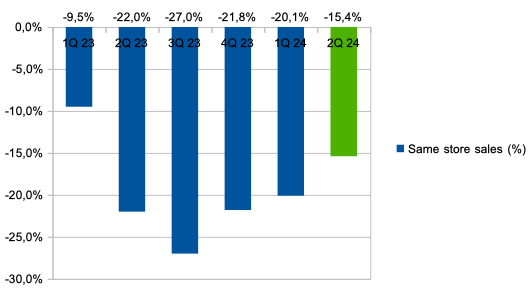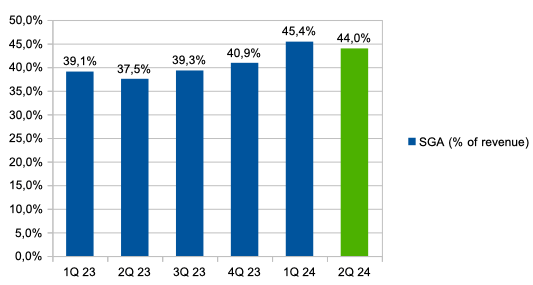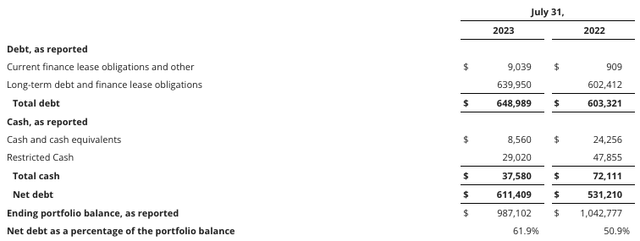Introduction
Shares of Conn’s, Inc. (NASDAQ:CONN) have fallen 42% YTD. In my previous article, I recommended selling the stock, since then the company’s quotes have risen by 2%, while the S&P 500 index has shown a rise of 2.7%. In my article, I would like to analyze current business trends and update my view of the company.
You can see my previous articles about the company here:
1. Conn’s: Continuation Of Negative Trends In Revenue And Profitability
2. Conn’s: Still Weak Trends And Unclear Outlook
Conn’s sells home furnishings in the US market. The main revenue segments are retail (79% of revenue) and the credit segment (21% of revenue). At the end of FQ2 2024, the company has 175 stores in 15 states.
Investment thesis
Despite the fact that the rate of decline in revenue is slowing down and the operating loss (% of revenue) is shrinking, I believe that it is still not the best time to buy the dip. Although the company’s management says that the new strategic initiatives to simplify the application for credit instruments and optimize marketing costs are in line with expectations, I believe that in the next two quarters the company’s financial performance will continue to be under serious pressure.
FQ2 2024 Earnings Review
The company’s revenue decreased by 11.5% YoY. The largest contribution to the decline in revenue was made by the retail segment, where revenue decreased by 12.8% YoY due to a decrease in same store sales by 15.4% YoY, while in the credit segment revenue decreased by 5.7% YoY.

Same store sales (%) (Company’s information)
Gross profit margin increased from 47.3% in Q2 2023 (fiscal) to 49.8% in Q2 2024 (fiscal) thanks to an increase in gross profit margin in the retail segment from 34.6% to 36.9% due to lower costs on freight, increasing product prices and favorable product mix.

Gross profit margin (consolidated) & gross profit margin (retail segment) (Company’s information)
SGA spending (% of revenue) increased from 37.5% in Q2 2023 (fiscal) to 44.0% in Q2 2024 (fiscal) due to reduced economies of scale and new store openings.

SGA (% of revenue) (Company’s information)
Thus, the operating loss (% of revenue) was 5%. Operating loss (% of revenue) in the retail segment increased from 0.0% in Q2 2023 (fiscal) to 4.2% in Q2 2024 (fiscal), while operating loss in the credit segment (% of revenue) reached 7.1%.

Op. loss (% of rev) % Op. loss by segment (% of rev) (Company’s information)
The debt level for the quarter was approximately $650 million, up 5.5% quarter-on-quarter. Despite the fact that the cash balance is about $8.6 million, the company has the opportunity to increase its debt load by $230.1 million in accordance with the loan agreements.

Debt (Company’s information)
My expectations
Despite the fact that we have seen the first signs of a reduction in operating loss (% of revenue), I think it is still too early to talk about the normalization of financial indicators. I believe that the company’s operating income will continue to be in the negative zone in the next two quarters.
On the one hand, if the current gross profit margin remains sustainable due to the reduction in freight costs, this may support profitability in the retail segment, however, in my personal opinion, this is not enough to provide significant support to financial results, which we see on example results for Q2 2024 (fiscal).
In addition, spending on SGA (% of revenue) is quite high due to both reduced economies of scale and new store openings. On the one hand, the decrease in revenue growth leads to a deleverage effect, since part of the company’s operating expenses are fixed (rent, salary), on the other hand, in accordance with the comments of management during the Earnings Call, the company plans to open an additional 10 new stores in 2024 (fiscal) year, which can lead to: 1) additional one-time costs associated with the opening of new stores 2) a decrease in sales by 1 square meter, because those stores that were opened relatively recently are less efficient.
While we remain focused on managing costs, we continue to expect annual SG&A expenses to increase year-over-year by $15 million to $25 million, primarily due to new stores and investments in our e-commerce growth strategy.
Risks
Margin: decrease in credit requirements for potential buyers may lead to an increase in the cost of provisions for bad debts in the credit segment, which may also contribute to a decrease in profitability.
Debt: an increase in leverage could lead to an increase in interest expenses and have a negative impact on the operating profitability of the business.
Valuation & Conclusion
Valuation Grade is A+. Under EV/Sales (FWD) and P/S (FWD) multiples, the company trades at 0.9x and 0.08x respectively, implying a discount to the sector median of around 21% and 91%, respectively. At the moment, in my opinion, the company deserves a discount due to the size of the business, lower revenue growth, negative operating margins, high leverage and lack of competitive advantages.
Thus, I do not see any catalysts or growth drivers in the coming quarters, while I expect the company’s financial results to continue to be under significant pressure, so I would like to reiterate my Sell recommendation.
Read the full article here









Leave a Reply